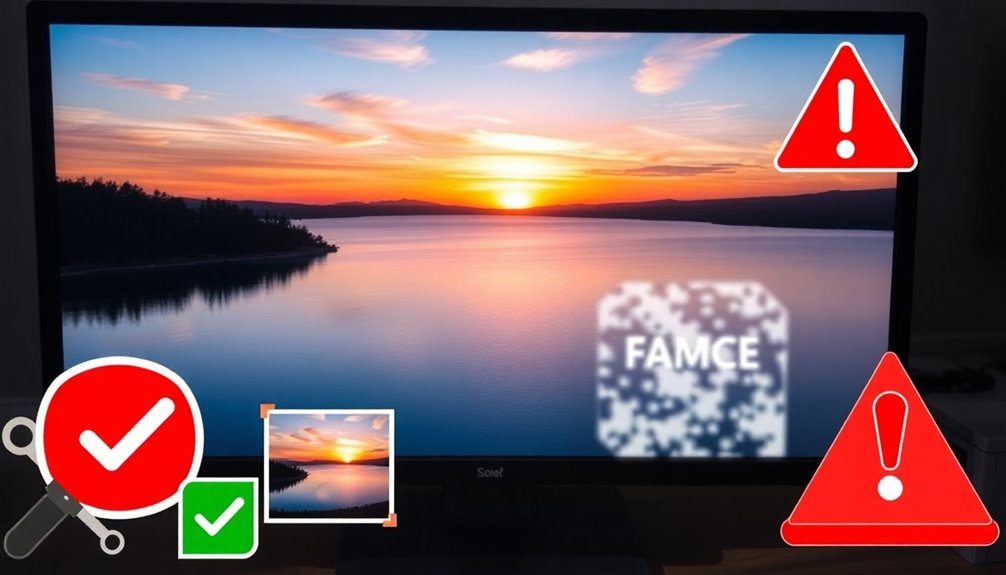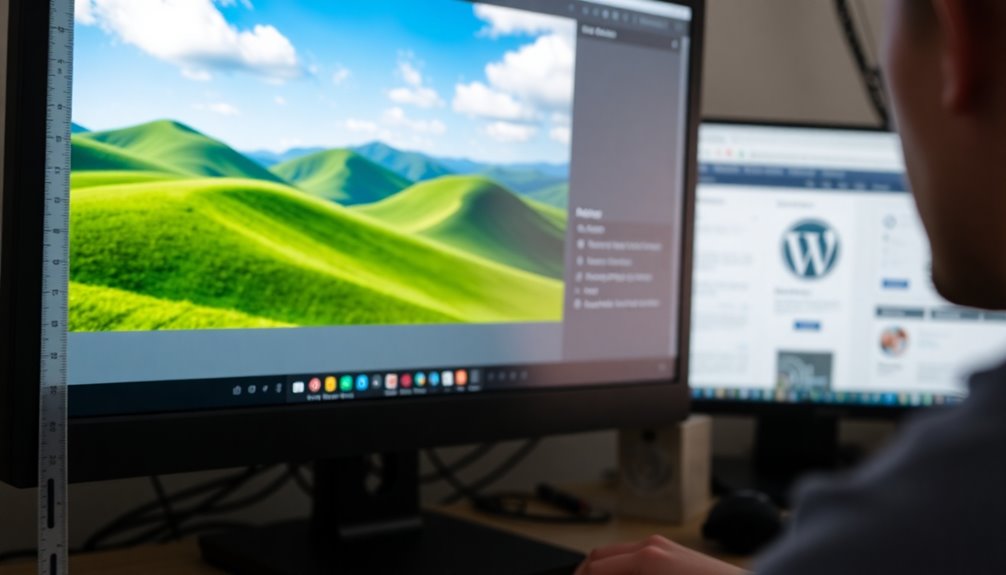Resizing media before uploading to WordPress is essential for enhancing site performance and user experience. It reduces page load times, which can keep visitors engaged and lower bounce rates. Optimized images can also save bandwidth costs and potentially boost your search engine rankings. Plus, properly sized visuals help fit your layout seamlessly. If you want to maximize your website's efficiency and learn more about effective practices, there's plenty of valuable information ahead.
Understanding the Importance of Resizing and Compressing Media
When you resize and compress media for your WordPress site, you're not just saving storage space; you're also enhancing user experience.
Resizing images to fit your layout not only improves aesthetics but also reduces unnecessary data transfer. This leads to faster page load times, which is vital since visitors often leave if a page takes more than three seconds to load. Additionally, caching plugins can significantly speed up your site, further improving load times during high traffic periods. Regular backups with backup plugins ensure that your media files are protected, allowing for quick recovery in case of any data loss.
Furthermore, compressing images helps in managing large media files that can negatively affect your site's SEO. Search engines favor faster-loading sites, making image optimization essential for better visibility. Using tools and plugins for compressing images can automate this process, ensuring your featured images maintain a balance between quality and file size while improving user engagement.
Key Benefits of Media Optimization
- Improved Loading Times: Optimized media can boost page speed by up to 70%, making your site faster. Regular backups can also ensure that your content remains safe during updates and media changes.
- Better SEO Performance: Search engines favor quicker sites, so effective media optimization can lead to higher rankings. Consistent backups help maintain your site's integrity, ensuring that all optimized media is preserved.
- Lower Bounce Rates: Faster websites with optimized WordPress images keep visitors engaged, reducing bounce rates considerably. A proactive approach to data protection ensures that your site operates smoothly without interruptions, further enhancing user experience.
Incorporating these practices guarantees your images maintain quality while enhancing mobile responsiveness, ultimately benefiting both user accessibility and server storage costs. Additionally, higher retention rates ensure that visitors spend more time exploring your multimedia-rich content, leading to a more immersive experience.
Use Cases for Media Optimization

When you optimize media for your eCommerce site, you can improve product image quality and speed, which boosts sales. Additionally, implementing regular backups ensures that your optimized media is protected against data loss. Regular backups not only preserve your optimized images but also safeguard against unexpected threats that can compromise your website's integrity. Similarly, resizing visuals on your blog enhances engagement, keeping readers interested longer. Let's explore how these use cases can transform your online presence. Additionally, implementing performance optimization techniques can further enhance your site's loading speeds, ensuring a seamless user experience.
Ecommerce Site Performance
Optimizing images is essential for enhancing your eCommerce site's performance, especially since slow-loading pages can drive away potential customers.
Here are three key reasons to resize and compress images before upload:
- Improved User Experience: Faster-loading pages reduce bounce rates, keeping visitors engaged.
- Increased Conversions: Properly optimized images can boost your conversion rates by up to 20%, turning casual browsers into buyers.
- Cost Savings: Resizing large image files can save up to 50% in bandwidth costs, directly impacting your bottom line.
Blog Engagement Strategies
Improving your eCommerce site's performance through image optimization sets a strong foundation for engaging blog content.
By resizing and compressing images, you can achieve faster load times, enhancing user experience and encouraging readers to explore more of your blog. This leads to lower bounce rates; remember, 53% of mobile visitors abandon pages that take over three seconds to load.
With optimized images, you also create enhanced visual appeal, making your posts more shareable. Plus, improved mobile responsiveness caters to the 60% of web traffic from mobile users.
Finally, these SEO benefits help you rank higher in search results, bringing more visibility to your content.
Utilize WordPress plugins for effortless media optimization and watch your engagement soar!
Best Practices for Resizing and Compressing Media
When resizing and compressing media for your WordPress site, optimizing image dimensions is key to fitting your layout perfectly. Choosing the right file format can enhance both quality and loading speed. Plus, using bulk compression tools saves you time while ensuring your images remain sharp and efficient. Additionally, implementing robust security features during the upload process can help protect your site from potential vulnerabilities. Regularly assessing your upload limits is also essential to prevent issues when handling larger files, as exceeding these limits can lead to upload errors that disrupt your content management workflow.
Image Dimensions Optimization
Resizing images to the right dimensions before uploading them can drastically enhance your WordPress site's performance.
When you refine your images, you'll notice significant improvements in file size and page load times, leading to a better user experience.
Here are some best practices:
- Resize images to ideal dimensions (e.g., 300×200 for thumbnails, 1200×800 for sliders).
- Use tools like Adobe Photoshop or online compressors to reduce file size by up to 80% without losing quality.
- Implement plugins like WP Smush or ShortPixel for bulk compressing images and automatic resizing.
Regularly auditing your media library and resizing images can prevent unnecessary storage consumption and improve your SEO rankings, ensuring your site runs efficiently.
File Format Selection
Selecting the right file format can greatly impact your media's performance on WordPress, complementing the efforts you've made in resizing images.
For high-resolution images, use JPEG for maintaining color depth with smaller file sizes. If your image requires transparency, opt for PNG. For vector graphics like logos, SVG is ideal as it scales without losing quality.
Additionally, consider using WebP format, which often provides better compression than both JPEG and PNG without compromising quality.
Always guarantee your images are saved in the correct dimensions for their intended display size to avoid loading oversized files.
Regularly review older images and convert them to newer formats like WebP to boost loading times and enhance your website's overall performance.
Bulk Compression Tools
While optimizing your media library, using bulk compression tools can greatly streamline the process.
These tools, like ShortPixel and Smush, help you compress multiple files at once, enhancing load times and improving user experience.
Here are some best practices for bulk compression:
- Choose the Right Tool: Select a bulk compression tool that balances reducing the file size while ensuring quality remains intact.
- Regularly Compress Media Before Uploading: Make it a habit to compress images before uploading to keep your media library organized.
- Monitor Storage Needs: Keep an eye on server storage; bulk compression can lower hosting costs associated with excessive file sizes.
Comparing Resizing and Compression Tools

When you're optimizing images for WordPress, understanding the differences between resizing and compression tools is essential.
Resizing tools like Adobe Photoshop and GIMP let you adjust image dimensions, ensuring they're properly optimized for various devices without sacrificing quality. This process is crucial to maintain the website integrity that can be compromised by improperly sized media. Additionally, regular backups of your optimized files can safeguard against potential data loss.
On the other hand, compression tools such as ShortPixel and Smush greatly reduce file sizes—up to 80%—while minimizing quality loss, which boosts page load times and enhances SEO.
Online compressors like TinyPNG excel in lossy compression, making images smaller yet visually acceptable.
Additionally, using bulk optimization features in plugins can process multiple images at once.
Don't forget to choose the right file formats—like JPEG for photos and PNG for graphics—to maximize the benefits of both resizing and compression tools. Incorporating secure backup solutions can also protect your optimized media files from potential data loss.
Consequences of Ignoring Media Resizing and Compression
Neglecting media resizing and compression can seriously impact your website's performance and user experience.
When you upload large files without optimizing them, you risk:
- Slow page load times: Visitors may abandon your site if it takes more than three seconds to load.
- Increased bounce rates: A 1-second delay can lead to a 7% reduction in conversions, harming your overall success.
- Poor search engine rankings: Search engines prioritize faster sites, and unoptimized images affect your visibility. Additionally, image optimization techniques can significantly enhance loading times and improve user retention.
Conclusion
To sum up, resizing and compressing your media before uploading to WordPress isn't just a chore—it's essential for a smooth user experience and better site performance. You might think it's too time-consuming, but with the right tools, it can be quick and effortless. By taking a few moments to optimize your images, you'll not only enhance your site's speed and SEO but also keep your visitors engaged. Don't underestimate the impact of a well-optimized site!



